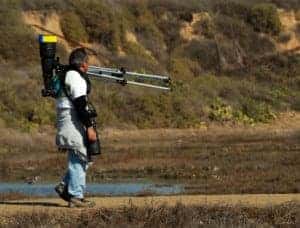
I received the following question via email and thought I should write a post here on ImprovePhotography.com to answer the question for the world. Here's the question: “I'm looking at buying a teleconverter for my Canon 100-400mm L f/4-5.6 IS lens but I am having difficulty determining if the1.4x or 2.0x teleconverter will still allow for autofocus with this lens. I use a Canon 60d camera.”
Background Information
First of all, a little background. DSLR cameras utilize two methods to focus: one is phase detection and the other is contrast detection. Despite what photographers always argue in the blogosphere, BOTH autofocus methods require contrast in order to focus. This is why it is difficult to focus on a large white sheet of paper. Since there is no contrast, it is difficult to find focus.
The second piece of background information you'll need to understand teleconverters is that, no matter what aperture you set on your camera, the DSLR will use the largest aperture available to find focus. It works like this: You set the aperture to f/8, but the lens stays at f/2.8 (or whatever the largest available aperture is) to focus. Once you press the shutter button to take the picture, the lens quickly snaps the aperture to f/8 and then clicks the shutter. This method allows the lens to gather as much light as possible for autofocus before closing down to take the shot.
What IS a teleconverter?
With that background, let's take a look at teleconverters and their unintended effects. A teleconverter looks like a short piece of a lens that goes between the DSLR and the lens. Its purpose is to magnify the focal length of the lens by 1.4, 1.7, or 2 times–depending on which teleconverter you buy. Beginning photographers on a budget love teleconverters because it provides a long lens at a low price. If only it were that simple…
The Drawbacks to Teleconverters
Teleconverters destroy image quality. Without exception, teleconverters always make lenses less sharp. While more expensive wildlife/sports lenses can do a decent job of controlling a teleconverter, it still means losing some image quality. If you have cheaper wildlife/sports lenses (under $2,000), then a teleconverter will bludgeon your image quality to a bloody pulp. Seriously, it's nasty. Don't do it.
I'm not at all saying that photographers on a budget are left out in the cold, but I don't want photographers on a budget to waste their money on gear that won't give them good bang for their buck.
If you purchase a teleconverter made by a manufacturer other than the manufacturer of your lens, some data will not be transmitted to the camera. For example, if I use a Kenko teleconverter on a Nikon 400mm f/2.8 lens, some of the data that my lens usually passes to the camera to aid in focusing will not be sent. Remember this when you go on Amazon and see that a 1.4x Tamron teleconverter costs about $130, while a Nikon teleconverter costs about $600. Make sure to buy a teleconverter that is of the same brand as your lens.
Unfortunately, teleconverters reduce the aperture size. A 1.4x teleconverter makes a lens lose 1 stop of light. A 1.7x teleconverter makes a lens lose 1.5 stops of light. A 2x teleconverter makes a lens lose two stops of light. What does this mean? It means that even the shortest teleconverter, a 1.4x, will transform an f/5.6 lens into an f/8!!!
So can I still autofocus with a teleconverter?
In the question that prompted this article to be written (a Canon 100-400 f/4-5.6 and a 1.4x teleconverter), the answer is no. Autofocus will not work, or at least will not work well. This combination will produce a 560mm f/8 lens. Most cameras require somewhere between f/5.6 and f/6.2 in order to focus. It depends on the camera, but f/8 probably won't allow for autofocus.
With this combination, manual focus is your best bet. For untrained photographers, manually focusing a 560mm lens on a crop frame camera would be nearly impossible. If you're wondering why it's tougher to manually focus a long lens, then check out this previous post.
There is a work-around to this problem by taping over three of the contacts on the teleconverter so the DSLR doesn't know you're using a teleconverter. This situation will allow autofocus to work, but it will work erratically and improperly.
The bottom line
Don't buy a teleconverter to try and make your tele-zoom a supertelephoto lens. The results will be disastrous. Teleconverters should only be used with high-end fast-aperture wildlife/sports lenses. Using teleconverters in other situations is a recipe for muddy image quality.

Yes – I agree I had both a 1.4 & 2 x Kenko teleconverters & found that auto focus was only at origunal focal length so useless here. Also the image quality was not as good. Flogged the 2 x converter on Ebay – lucky me. Kept the 1.4 for rare uses where quality was not of a primary nature – sounds dumb but it works for some situations. eg. take a stack of wedding pics & the client doesn’t look at quality they see what they they want eg . great pic of uncle Joe Even though slightly blurred AND very noisy.
The whole issue is where are you going to use it – if you want to win buck in comps forget it.
personally, i have found that putting a 1.4 TC on my Nikon 200-400 F4 (certainly not a cheap lens) produces very similar results of just cropping to the same om equivalent.